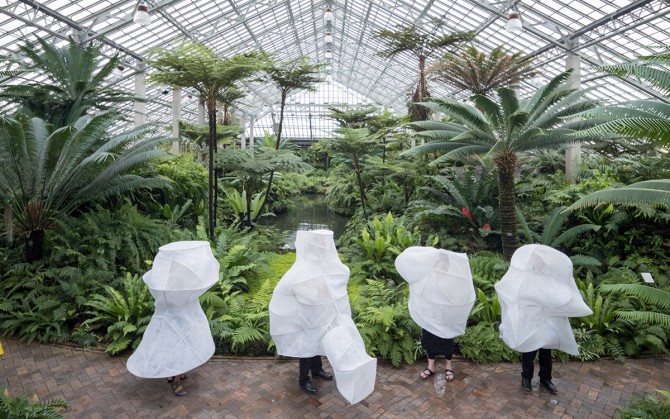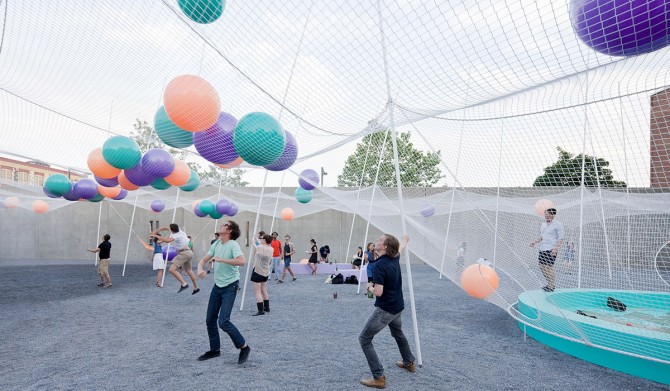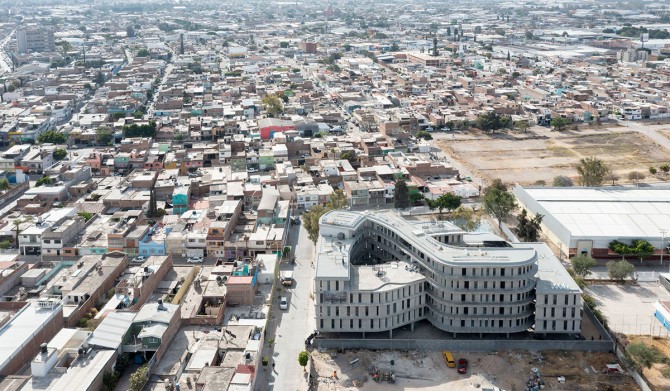
SO-IL's Amant Foundation campus building façade, currently under construction in Brooklyn, New York.
News directly from Cornell's colleges and centers
Who for whom: Florian Idenburg on SO-IL’s approach to design practice
By Mitchell Carson
Florian Idenburg, founder of the award-winning architecture firm SO-IL, and visiting faculty at AAP NYC, designs architecture that gives form and aesthetics to our world's most pressing questions. SO-IL's approach is often intuitive while respecting the immense responsibility architects have as "re-arrangers of atoms" and "organizers of instructions." The office's approach to design aims to reconnect people to their environments by agitating the public realm and empowering it with the ability to "hit you back." SO-IL, and Idenburg, accommodate the ever-changing nature of cities and spaces by maintaining an attitude of openness and accessibility, and addresses inequality by always asking the question: who is putting the building together and for whom? Above all else, it would seem, Idenburg sees architecture as an opportunity to produce surprise and wonder. His joy and fascination with the art form are infectious and radiate from his work. (The below interview is an abridged version of Carson and Idenburg's original conversation.)
MC: What conditions in our globalized society are you most concerned with, and how do you engage with them as an architect?
FI: The biggest thing is inequality. Second is the environment. But inequality is the thing that tears our social structures apart in our civic society. Our practice deals with inequality on many levels. We have tried to develop an architecture about realizing that one can learn from those who are different from you. This can be done through layering and transparency, or by establishing relationships in which people become aware of one another. We care about this on a very fundamental level, not just as it relates to architectural design.
On the other hand, we're getting more and more interested in labor and labor practices and the relationship between, say, technology and craft, and the process of putting a building together. Who puts it together and for whom? We've always tried to stay away from either working purely as emergency workers, with projects that are there only for a social cause. We are also staying far away from only being architects that work for the few clients who can afford architecture for themselves. For us, it has always been a question of making design and good design accessible to all. So, we try to work on the most extreme ends of the spectrum. We also try to show how those streams come together. I'll leave it at that for now.
MC: Is there an emerging model for design practice specific to the urgencies you speak of? Can the two priorities of "good design" and "design for good" be equally at work and productive?
FI: Yes. I always say a good program doesn't make it a good building, right? If you make an orphanage in Rwanda, it doesn't make it a good building. It's certainly a great mission to house, but it doesn't automatically make for good architecture. I think it is important that we can discuss good architecture. After doing all the right things ethically and programmatically, you can still design a very poor building. We cannot forget that architects ultimately make form or make spaces and give form and organize material in ways that can be elegant or inelegant. We try to do both. We try to give these questions certain aesthetics. For example, we did an installation, a collaboration with Ana Prvački, the artist, for the Chicago Biennial called L'air pour l'air, which was a performance that dealt with the idea of pollution. How do you give pollution form, so to say? How can you give it aesthetics? These are the things that interest us, and it is different from: hey, how do we tackle air pollution? It is more like: how can we establish aesthetics that address some of these questions?
MC: Is this what you meant when you said that "design justified through program is born dead?"
FI: Yeah. That's because programs change all the time. The things that I say start sounding like truisms, but program is currency that buys you space. Nobody understands space. There are very few people who really understand plans. But most people understand a program. And a program is something that translates money to space. So, you use a program as a way to buy space. You need 200 of this and 300 of this and then 10 of this, and it becomes somewhat like a shopping list. It doesn't mean that people actually use the space that way. And anyway, what does it mean to call something a "classroom?" A classroom may have a certain set of functions, but many different things can happen there. That space can have a certain size and proportion, but it can be used for many other things as well, and over time it certainly will be used for many other things. Program sometimes only goes as far as buying you space. You still need to give that space form. Program has certainly been used in architecture a lot, if only as an excuse to make other "types" of buildings. Form used to follow function, after all. This is all to say that programs can be used to design buildings, but a program in itself is not something sacred. It's just a currency, in my mind.
MC: When speaking about your MoMA PS1 installation, you said that "architecture can agitate the public realm." You mentioned that your projects often do. I noticed that architects sort of delight in that fact when they know that their building is affecting so much. I do think it is also somewhat controversial among the general public, when you put it in such terms, but I'm curious what you meant by that. Is it important to agitate as architects, and how can one do it carefully?
FI: It's really about awareness. It's about awareness of our world and our physical surroundings and the notion of being grounded to a site, a place, and where you are. We have seen ourselves all disappearing into our devices for quite a while now. People have become much more numb about the spaces around them. With the installation for PS1, we wanted to make an installation that could almost hit you, so to say. We wanted to make something that was very tactile, very physical, but would respond back to you. In this case, it was very physical. It became a physical game between the visitor and the space. The physicality of architecture is something we're very interested in. This is about matter and real things, that's why we talk about gravity and structure because we are dealing with our material and physical world. There's a digital world and there is a physical world. We can learn a ton from the digital world, but as architects, I see our realm as the physical world. So, if a building can rub you the wrong way, so to say, it puts you in the here and now, rather than in the digital clouds. That's what we try to do with our buildings. They try to say: hey, listen, you are here.
MC: I'm curious how newness falls into all of this. I see, in your work, something about subverting expectations or creating never-seen-befores. I'm wondering if this is an aesthetic inclination, or is it more of a design philosophy? Do we have a responsibility to the field of architecture itself to make new things?
FI: New is a very funny term. I worked in Japan for eight years. It's very easy in Japan to say we tried something new. It sounds incredibly poetic and easily justifiable just to say, "we're trying something new." Perhaps it's the same as a "good program" in that we are quick to say that it's already good enough if it's a good program or a new idea. Calling something a "new building" doesn't make it a good building, in the same way one calls an orphanage in Rwanda a good building before anyone has ever seen it. "New" is often overused by somebody who cannot really define what they're doing. I think we use it ourselves sometimes, like when we are trying to find a new approach. Of course, it doesn't make it a good approach just because it is new. I don't know if it's the same as "new," but I do think we try to do things differently, or we certainly don't find the most conventional way to do things. We just ask, why would we do it this way and not another way? There aren't so many materials to choose from in architecture, right? There is concrete, steel, wood, glass...there are a few more here or there, but that's pretty much it. If you're a cook in a kitchen and you have only five ingredients, how many variations can you possibly cook? We try very hard to find different variations within this quite limited palette to continue to produce surprise and some sort of wonder. This is our interest, it is also our joy. We think that it makes buildings more intriguing and fascinating.
MC: What do you notice when you look at the architecture around you, particularly as you work around the world? Does the architecture speak volumes about this period of time, the 2020s?
FI: There are a few very pressing issues today that, in some way, architecture is responding to and could lead toward, all of which come down to justice. The largest issues are racial justice, social justice at a more global scale, and environmental justice. As an architect, it is important to have an awareness of our role within all of it. Ultimately, we decide where certain materials arrive, where they are to exist in the world. We are basically rearranging the atoms of the world, and it has a direct impact on both social and environmental issues. This awareness is really sinking in throughout the fields of architecture, and so you cannot be at liberty anymore while being ignorant about certain things. There is so much more information available now. Zaha Hadid may have said that it is not the architect's responsibility to think about the stadium workers, but I think it is something we cannot be ignorant about, meaning we cannot say that we didn't know after the fact. We cannot hide from the fact that there are prevailing issues. If you see what is happening in Europe at this moment regarding materials and sustainability, it is effectively changing the discipline to a level that certain materials won't be available to us anymore. We will have to completely adjust the way we work because we know our impact on the earth. With the sheer amount of information available and the ability to track and represent information allowing us to see much more clearly, there's no disguise anymore. There's still misinformation, and there's not "total information," but there is so much more of it and it means we have to adjust the way we design.
MC: This is an open-ended one. How do you design future culture?
FI: Perhaps it has mostly to do with intuition. It is the culture that is changing, so how do you design for something that is evolving? I think it is reflected in our attitude, which has to do with openness and allowing things to shift while certain things stay the same. But it is a big question, how do you allow for things to transform and for things to be taken over and occupied and reinterpreted? A lot of the things we do are very intuitive. Sometimes we are just fascinated by something. We see something, pick it up, explore it. This I cannot explain.
Media Contact
Get Cornell news delivered right to your inbox.
Subscribe



